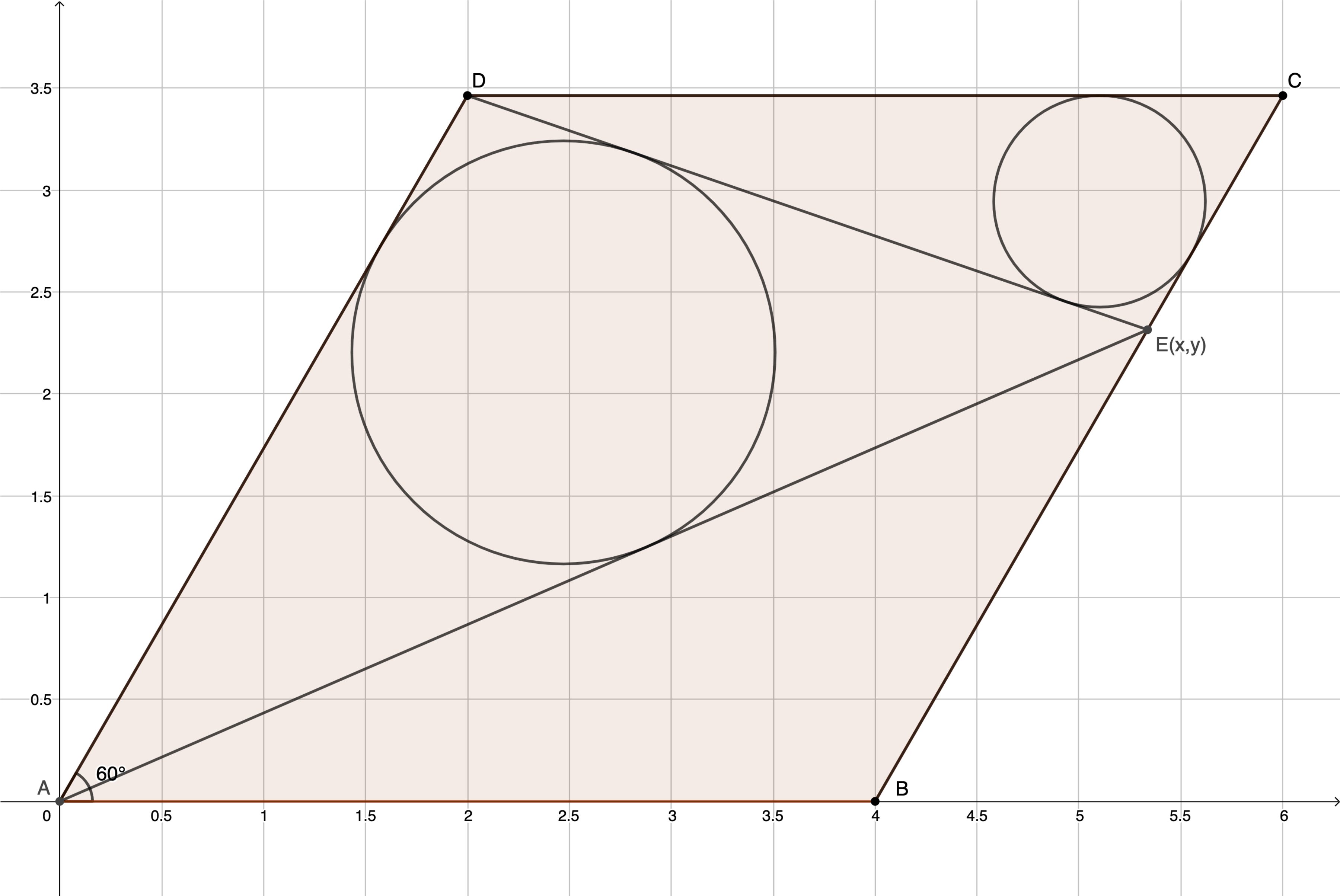Rhombus Rhumble

is a rhombus positioned on the coordinate plane with on the origin, as shown in the figure. Its inferior angle is and the length of each side is . is positioned on such that the radius of the larger circle is twice the radius of the smaller circle. Find the value of the -coordinate of . If it is a root of , where , and gcd , submit .
The answer is 13.
This section requires Javascript.
You are seeing this because something didn't load right. We suggest you, (a) try
refreshing the page, (b) enabling javascript if it is disabled on your browser and,
finally, (c)
loading the
non-javascript version of this page
. We're sorry about the hassle.
Let the x -coordinate of E be x .
Since A B = 4 and the exterior angle of ∠ A B E is 6 0 ° , B E = 2 ( x − 4 ) = 2 x − 8 , which means C E = B C − B E = 4 − ( 2 x − 8 ) = 1 2 − 2 x .
By the law of cosines on △ A B E , A E = A B 2 + B E 2 − 2 ⋅ A B ⋅ B E ⋅ cos A B E = 4 2 + ( 2 x − 8 ) 2 − 2 ⋅ 4 ⋅ ( 2 x − 8 ) ⋅ cos 1 2 0 ° = 2 x 2 − 6 x + 1 2 .
By the law of cosines on △ D C E , D E = C D 2 + C E 2 − 2 ⋅ C D ⋅ C E ⋅ cos D C E = 4 2 + ( 1 2 − 2 x ) 2 − 2 ⋅ 4 ⋅ ( 1 2 − 2 x ) ⋅ cos 6 0 ° = 2 x 2 − 1 0 x + 2 8 .
The area of △ A D E is A △ A D E = 2 1 ⋅ b ⋅ h = 2 1 ⋅ 4 ⋅ 2 3 = 4 3 .
The area of △ D C E is A △ D C E = 2 1 ⋅ C D ⋅ C E ⋅ sin D C E = 2 1 ⋅ 4 ⋅ ( 1 2 − 2 x ) ⋅ sin 6 0 ° = 2 3 ( 6 − x ) .
The inradius of △ A D E is R = A D + D E + A E 2 A △ A D E = 4 + 2 x 2 − 1 0 x + 2 8 + 2 x 2 − 6 x + 1 2 2 ⋅ 4 3 = 2 + x 2 − 1 0 x + 2 8 + x 2 − 6 x + 1 2 4 3 .
The inradius of △ D C E is r = C D + C E + D E 2 A △ D C E = 4 + ( 1 2 − 2 x ) + 2 x 2 − 1 0 x + 2 8 2 ⋅ 2 3 ( 6 − x ) = 8 − x + x 2 − 1 0 x + 2 8 2 3 ( 6 − x ) .
Since the radius of the larger circle is twice the radius of the smaller circle, R = 2 r , and this simplifies to:
Therefore, f ( 6 ) = 2 ( 6 ) 3 − 2 2 ( 6 ) 2 + 7 6 ( 6 ) − 8 3 = 1 3 .